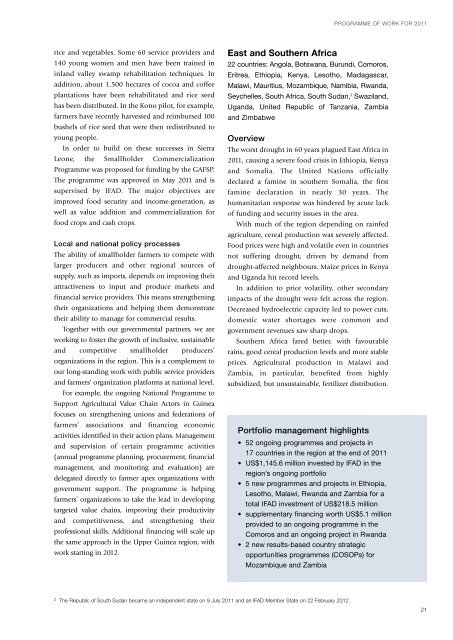ANNUAL REPORT 2011 - IFAD
ANNUAL REPORT 2011 - IFAD
ANNUAL REPORT 2011 - IFAD
You also want an ePaper? Increase the reach of your titles
YUMPU automatically turns print PDFs into web optimized ePapers that Google loves.
ice and vegetables. Some 60 service providers and<br />
140 young women and men have been trained in<br />
inland valley swamp rehabilitation techniques. In<br />
addition, about 1,500 hectares of cocoa and coffee<br />
plantations have been rehabilitated and rice seed<br />
has been distributed. In the Kono pilot, for example,<br />
farmers have recently harvested and reimbursed 100<br />
bushels of rice seed that were then redistributed to<br />
young people.<br />
In order to build on these successes in Sierra<br />
Leone, the Smallholder Commercialization<br />
Programme was proposed for funding by the GAFSP.<br />
The programme was approved in May <strong>2011</strong> and is<br />
supervised by <strong>IFAD</strong>. The major objectives are<br />
improved food security and income-generation, as<br />
well as value addition and commercialization for<br />
food crops and cash crops.<br />
Local and national policy processes<br />
The ability of smallholder farmers to compete with<br />
larger producers and other regional sources of<br />
supply, such as imports, depends on improving their<br />
attractiveness to input and produce markets and<br />
financial service providers. This means strengthening<br />
their organizations and helping them demonstrate<br />
their ability to manage for commercial results.<br />
Together with our governmental partners, we are<br />
working to foster the growth of inclusive, sustainable<br />
and competitive smallholder producers’<br />
organizations in the region. This is a complement to<br />
our long-standing work with public service providers<br />
and farmers’ organization platforms at national level.<br />
For example, the ongoing National Programme to<br />
Support Agricultural Value Chain Actors in Guinea<br />
focuses on strengthening unions and federations of<br />
farmers’ associations and financing economic<br />
activities identified in their action plans. Management<br />
and supervision of certain programme activities<br />
(annual programme planning, procurement, financial<br />
management, and monitoring and evaluation) are<br />
delegated directly to farmer apex organizations with<br />
government support. The programme is helping<br />
farmers’ organizations to take the lead in developing<br />
targeted value chains, improving their productivity<br />
and competitiveness, and strengthening their<br />
professional skills. Additional financing will scale up<br />
the same approach in the Upper Guinea region, with<br />
work starting in 2012.<br />
PROGRAMME OF WORK FOR <strong>2011</strong><br />
East and Southern Africa<br />
22 countries: Angola, Botswana, Burundi, Comoros,<br />
Eritrea, Ethiopia, Kenya, Lesotho, Madagascar,<br />
Malawi, Mauritius, Mozambique, Namibia, Rwanda,<br />
Seychelles, South Africa, South Sudan, 2 Swaziland,<br />
Uganda, United Republic of Tanzania, Zambia<br />
and Zimbabwe<br />
Overview<br />
The worst drought in 60 years plagued East Africa in<br />
<strong>2011</strong>, causing a severe food crisis in Ethiopia, Kenya<br />
and Somalia. The United Nations officially<br />
declared a famine in southern Somalia, the first<br />
famine declaration in nearly 30 years. The<br />
humanitarian response was hindered by acute lack<br />
of funding and security issues in the area.<br />
With much of the region depending on rainfed<br />
agriculture, cereal production was severely affected.<br />
Food prices were high and volatile even in countries<br />
not suffering drought, driven by demand from<br />
drought-affected neighbours. Maize prices in Kenya<br />
and Uganda hit record levels.<br />
In addition to price volatility, other secondary<br />
impacts of the drought were felt across the region.<br />
Decreased hydroelectric capacity led to power cuts,<br />
domestic water shortages were common and<br />
government revenues saw sharp drops.<br />
Southern Africa fared better, with favourable<br />
rains, good cereal production levels and more stable<br />
prices. Agricultural production in Malawi and<br />
Zambia, in particular, benefited from highly<br />
subsidized, but unsustainable, fertilizer distribution.<br />
Portfolio management highlights<br />
• 52 ongoing programmes and projects in<br />
17 countries in the region at the end of <strong>2011</strong><br />
• US$1,145.6 million invested by <strong>IFAD</strong> in the<br />
region’s ongoing portfolio<br />
• 5 new programmes and projects in Ethiopia,<br />
Lesotho, Malawi, Rwanda and Zambia for a<br />
total <strong>IFAD</strong> investment of US$218.5 million<br />
• supplementary financing worth US$5.1 million<br />
provided to an ongoing programme in the<br />
Comoros and an ongoing project in Rwanda<br />
• 2 new results-based country strategic<br />
opportunities programmes (COSOPs) for<br />
Mozambique and Zambia<br />
2 The Republic of South Sudan became an independent state on 9 July <strong>2011</strong> and an <strong>IFAD</strong> Member State on 22 February 2012.<br />
21

















